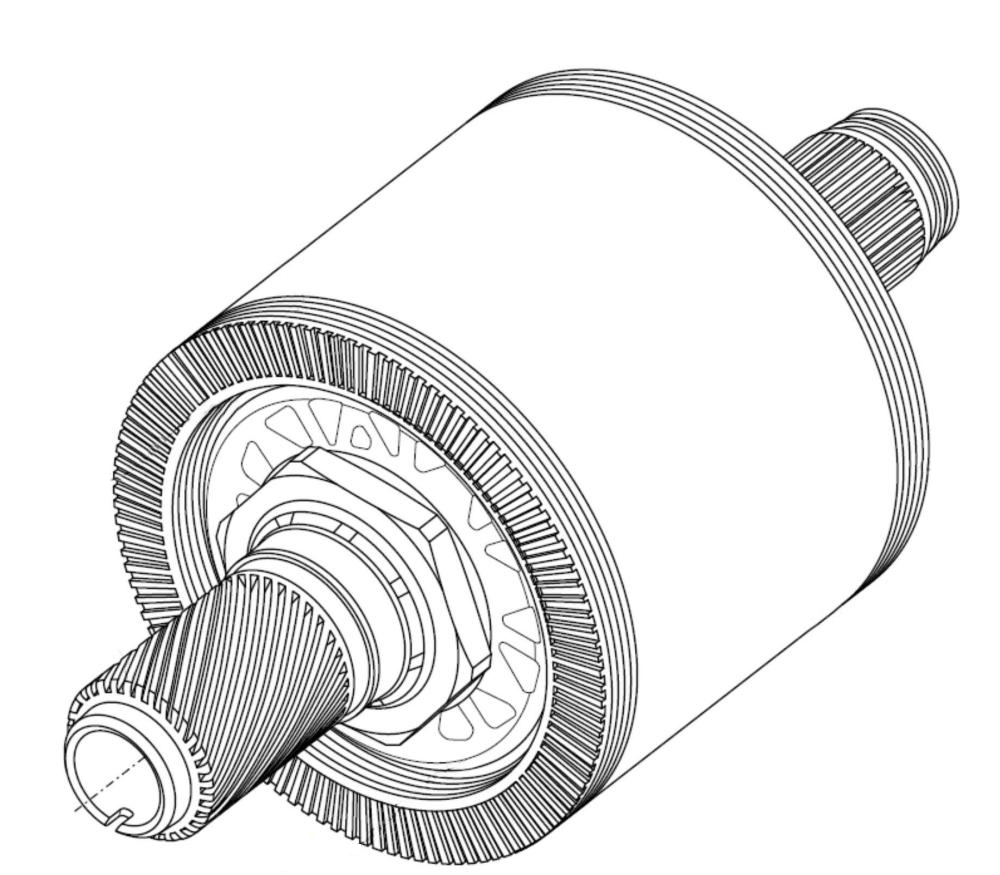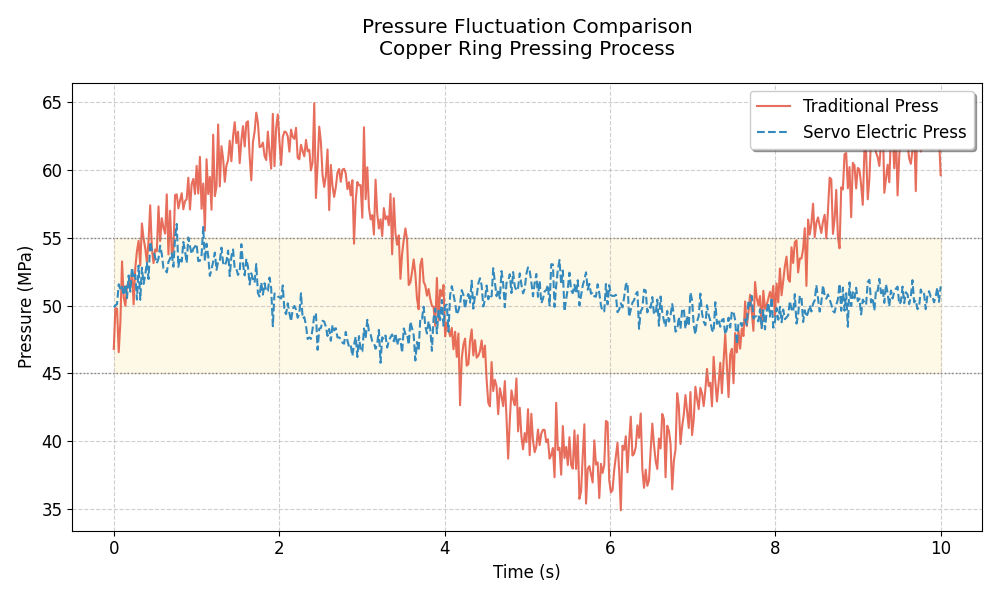In motor rotor manufacturing, the precision of the copper ring process directly determines motor performance and lifespan. The press-fitting process must simultaneously meet three key requirements: conductivity, mechanical strength, and thermal stability. Traditional press-fitting processes often suffer from insufficient precision, leading to high scrap rates and low efficiency. This article will analyze the top ten pain points in the industry and reveal how the XIRO Electric Servo Press achieves a breakthrough through technological innovation.
I. Analysis of the Ten Pain Points in Traditional Copper Ring Press-Fitting
1. Static Offset Causing Material Damage
Rotor shaft misalignment or stator installation errors (static eccentricity error > 30μm) cause initial misalignment during press-fitting. This results in asymmetric stress on the copper ring, leading to plastic deformation and increased contact resistance, ultimately reducing motor efficiency due to uneven electromagnetic field distribution.

Rotor Copper
(For confidentiality purposes, the product images shown are representative illustrations only and do not depict actual client-specific product)
2. Dynamic Eccentricity Leading to Fatigue Cracks
Excessive bearing wear or gear backlash (>0.02mm) leads to dynamic eccentricity, causing periodic positional drift during press-fitting. This increases path deviation, resulting in micro-cracks (>5μm) on the copper ring surface, compromising insulation.
3. Insufficient Force Control Accuracy in Hydraulic Systems
Traditional hydraulic systems have a force control accuracy of only ±3%FS (Full Scale), leading to uneven stress distribution (18%) when the interference fit exceeds 0.05mm. This results in excessive ovalization (> IT8 tolerance) and unstable contact resistance.
4. Uncontrolled Thermal Stress Deformation
Frictional heating during press-fitting (local temperature >120°C) causes axial displacement due to differences in the thermal expansion coefficients of the copper ring (16.5×10⁻⁶/°C) and rotor steel base (11×10⁻⁶/°C). This imbalance leads to rotor unbalance, increasing motor vibration.
5. Weak High-Frequency Vibration Suppression
Traditional equipment struggles to suppress high-frequency mechanical vibrations (>200Hz) below 40dB, leading to impact forces >10N during press-fitting. This increases the probability of micro-cracks (>4.8%) and insulation failure.
6. Difficulty Controlling Pressure Fluctuations
During copper ring press-fitting, force surges occur at transition stages (pressure fluctuations > ±5%FS), leading to yield strength loss (12%-18%) and microstructural damage that reduces fatigue life by 30%.
7. Poor Adaptability to Various Copper Ring Specifications
Different ring sizes require different press-fitting parameters. Traditional presses require manual mechanical limit adjustments, taking 45-90 minutes per change, with repositioning accuracy of only ±0.1mm. This is unsuitable for mass production of high-precision motor rotors.
8. High Omission Rate in Manual Inspection
70% of small and medium manufacturers rely on manual inspection, monitoring only the final press depth while ignoring the press-fitting curve shape, leading to undetected defects such as:
Initial misalignment (>0.1mm), amplifying path deviation by 300%.
Pressure decay rate >5N/s in the holding phase, indicating a 47% risk of springback.
9. Difficulty in Tracing Batch Defects
Manual inspection lacks real-time monitoring, making it difficult to identify batch defects (such as stress relaxation and micro-cracks), resulting in quality control failures.
10. High Maintenance Costs for Tooling
Hydraulic system aging and frequent seal wear account for 15%-20% of total equipment investment, significantly increasing production costs.
II. Technological Advantages of XIRO Electric Servo Press
1. High-Precision Force-Displacement Dual Closed-Loop Control
24-bit encoder (±0.001mm resolution) combined with high-precision strain gauge force sensors for precise feedback.
Real-time dynamic correction (5000 samples/sec) adjusts servo motor torque using PID algorithms, keeping path deviation ≤ ±0.005mm.
Peak torque threshold protection prevents plastic deformation by automatically slowing down near the copper ring’s yield limit.
Experimental Verification:
Practical application of the XIRO Electric Servo Press has demonstrated a reduction in copper ring press-fitting path deviation from the industry average of 3% to 0.1%.
98% decrease in plastic deformation occurrence.
Interference fit stress distribution non-uniformity ≤3% (compared to 18% in traditional processes).
Achieves stable IT6-grade ovality control.
2. Dynamic Gap Compensation & High-Frequency Vibration Suppression
Feedforward torque compensation (gain value 0.8-1.2) offsets mechanical backlash (0.1-0.3mm).
High-response servo motor (>500Hz bandwidth) with adaptive filtering algorithms suppresses vibrations >200Hz by more than 60dB.
Segmented precision control reduces contact impact force to<1N, preventing sudden load shocks.
Experimental Verification:
Under the influence of mechanical gap compensation and high-frequency vibration suppression, dynamic eccentricity error has been reduced to ±0.02mm, compared to traditional hydraulic press-fitting.
Surface micro-crack occurrence rate dropped from 4.8% to 0.03%.
High-frequency vibration energy reduced to 1/10 of conventional equipment.
3. Intelligent Temperature Control & Segmented Pressing Strategy
500Hz infrared thermal imaging detects real-time surface temperature changes (accuracy ±1°C).
Speed auto-adjustment based on temperature feedback to suppress thermal expansion.
Four-Stage Pressing Process:
Fast approach (500mm/s) for positioning.
Detection stage (0.05mm/s) to determine exact fit position.
Pressing stage with smooth pressure gradients (≤50N/ms).
Holding stage (±0.5% FS pressure control) to eliminate material rebound.

Pressure Fluctuation Comparison: Traditional Press vs. XIRO Electric Servo Press
(Data source: XIRO)
Experimental Verification:
Axial displacement caused by thermal expansion is controlled to <5μm(IT6 tolerance level).
Yield strength loss during the holding phase is limited to <3%, increasing fatigue life by 40%.
Intelligent speed switching: Rapid approach speed 500mm/s + detection speed 0.1mm/s.
Single-piece press-fitting cycle reduced by 40%.
4. Automated Production & Digital Quality Management
100+ sets of pre-stored copper ring templates, auto-adjustable within 3 seconds via barcode scanning.
SPC real-time monitoring ensures CpK ≥ 1.67, with automatic defect sorting.
Full-process data tracking (10,000+ records), supporting SQL database export & MES integration.
Experimental Verification:
Compared to low-precision and low-efficiency traditional presses, an EV motor manufacturer improved changeover efficiency by 20x using the XIRO Electric Servo Press.
Mass production comprehensive efficiency increased by 35%.
Batch defect interception rate of 99.9%, reducing return rates from 5.2% to 0.07%, significantly cutting production costs.
5. High Reliability & Maintenance Cost Optimization
All-electric servo design eliminates hydraulic components, extending key part lifespan >100,000 hours.
Self-diagnostic system monitors bearing temperature, motor current, and alerts for potential faults.
Modular design enables quick component replacement, reducing maintenance downtime to<30 minutes.
Experimental Verification:
Total maintenance costs reduced by 30% compared to traditional presses.
Provides 2-year free warranty and lifetime after-sales service.
III. Common Customer Questions (Q&A)
Q1: How does the XIRO press adapt to different copper ring sizes?
A: 200+ templates pre-stored, parameters adjust automatically in 3 seconds via barcode scanning.
Q2: How does it prevent thermal stress-induced axial displacement?
A: Real-time thermal imaging, adaptive speed control, and segmented pressure holding limit displacement to<5μm.
Q3: Is maintenance complex?
A: The servo system requires no hydraulic oil, reducing maintenance costs by 30% and supports remote diagnostics.
Q4: Is operation difficult?
A: Touchscreen interface (smartphone-like UI), automatic fault diagnosis, and clear troubleshooting guides.
Q5: Can it ensure full-process quality traceability?
A: 0.1ms high-frequency data logging, SPC reports, and SQL database integration for batch defect tracing.
Conclusion
XIRO Electric Servo Press achieves comprehensive process upgrades through high-precision closed-loop control, dynamic compensation algorithms, intelligent temperature management, and digital quality tracking. This reduces defect rates from 5% to 0.2%, improves efficiency, and enhances traceability—offering a zero-defect solution for the motor industry. Contact us for a customized press-fitting solution!






